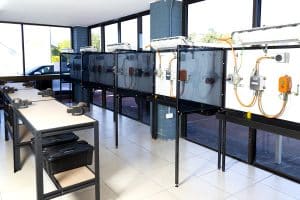Roar Solutions Can Be Fun For Everyone
Roar Solutions Can Be Fun For Everyone
Blog Article
The Basic Principles Of Roar Solutions
Table of ContentsNot known Factual Statements About Roar Solutions See This Report on Roar SolutionsSome Known Questions About Roar Solutions.
In order to protect installments from a prospective surge a method of analysing and classifying a potentially hazardous area is needed. The function of this is to make sure the appropriate choice and setup of equipment to eventually prevent a surge and to make certain safety and security of life.
(https://sketchfab.com/roarsolutions)
No equipment ought to be set up where the surface temperature level of the equipment is more than the ignition temperature of the provided hazard. Below are some common dust unsafe and their minimal ignition temperature. Coal Dirt 380C 225C Polythene 420C (melts) Methyl Cellulose 420C 320C Starch 460C 435C Flour 490C 340C Sugar 490C 460C Grain Dust 510C 300C Phenolic Resin 530C > 450C Aluminium 590C > 450C PVC 700C > 450C Soot 810C 570C The chance of the threat being existing in a focus high sufficient to create an ignition will certainly vary from place to area.
In order to categorize this danger an installation is separated right into areas of danger relying on the quantity of time the harmful exists. These areas are referred to as Areas. For gases and vapours and dirts and fibres there are 3 zones. Area 0 Zone 20 A hazardous atmosphere is highly most likely to be existing and might be existing for extended periods of time (> 1000 hours per year) and even continually Zone 1 Area 21 A hazardous atmosphere is feasible yet unlikely to be present for lengthy durations of time (> 10 450 C [842 F] A category of T6 implies the minimum ignition temperature is > 85 C [185 F] Harmful location electrical devices possibly designed for usage in greater ambient temperature levels. This would showed on the ranking plate e.g. EExe II C T3 Ta + 60C( This implies at 60C ambient T3 will not be surpassed) T1 T1, T2, T3, T4, T5, T6 T2 T2, T3, T4, T5, T6 T3 T3, T4, T5, T6 T4 T4, T5, T6 T5 T5, T6 T6 T6 A T Course score of T1 means the maximum surface area temperature level created by the tool at 40 C is 450 C. Assuming the linked T Course and Temperature level ranking for the equipment are appropriate for the location, you can constantly utilize a tool with an extra stringent Division ranking than needed for the area. There isn't a clear response to this question. It truly does rely on the kind of devices and what repair work require to be brought out. Tools with specific examination procedures that can't be executed in the field in order to achieve/maintain 3rd party score. Should come back to the factory if it is prior to the tools's service. Area Repair Work By Authorised Personnel: Difficult screening may not be required however particular treatments may require to be complied with in order for the equipment to preserve its 3rd event score. Authorised workers must be employed to execute the job properly Repair service have to be a like for like replacement. New part have to be thought about as a straight replacement needing no special screening of the equipment after the repair is full. Each tool with a hazardous score need to be evaluated individually. These are laid out at a high level listed below, however for even more comprehensive info, please refer straight to the standards.
Roar Solutions for Dummies
The tools register is an extensive data source of equipment records that includes a minimum set of areas to determine each item's area, technological specifications, Ex lover category, age, and environmental information. The ratio of In-depth to Shut inspections will certainly be identified by the Equipment Threat, which is evaluated based on ignition risk (the possibility of a source of ignition versus the likelihood of a flammable environment )and the dangerous location classification
( Zone 0, 1, or 2). Implementing a robust Risk-Based Evaluation( RBI )method is important for ensuring compliance and safety and security in managing Electrical Tools in Hazardous Locations( EEHA).
All About Roar Solutions

In terms of eruptive risk, an unsafe area is a setting in which an explosive atmosphere exists (or might be anticipated to be present) in amounts that call for unique precautions for the construction, installment and usage of equipment. eeha certificate. In this short article we check out the difficulties encountered in the work environment, the risk control measures, and the needed proficiencies to work securely
It issues of modern-day life that we make, save or handle an array of gases or liquids that are considered combustible, and a series of dusts that are deemed combustible. These materials can, in certain conditions, form eruptive environments and these can have major and heartbreaking repercussions. A lot of us recognize with the fire triangle get rid of any kind of among the three elements and the fire can not occur, yet what does this mean in the context of harmful areas? When breaking this down right into its easiest terms it is basically: a mix of a particular quantity of release or leak of a particular compound or material, mixing with ambient oxygen, and the visibility of a source of ignition.
In a lot of instances, we can do little about the levels of oxygen in the air, but we can have substantial influence on resources of ignition, for instance electrical equipment. Dangerous locations are documented on the harmful location category drawing and are recognized on-site by the triangular "EX" indication. Below, amongst various other key details, areas are split right into 3 kinds relying on the hazard, the chance and duration that an eruptive atmosphere will certainly exist; Area 0 or 20 is considered the most harmful and Zone 2 or 22 is regarded the least.
Report this page